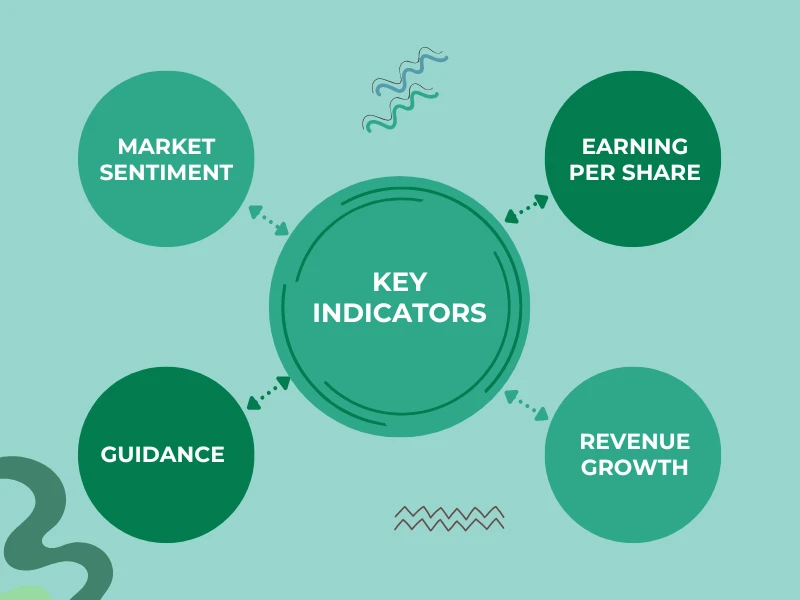The Hidden Power of Earnings Calendar Trading

Introduction
Earnings reports, a cornerstone of trading, offer invaluable insights into a company's financial health and future prospects. Mastering the art of interpreting and trading around earnings announcements can be a game-changer for investors. In this article, we'll delve into the significance of earnings reports and provide a comprehensive overview of the earnings calendar. This knowledge will empower beginner traders, instilling in them the confidence to navigate this critical aspect of the market.
Earnings reports, also known as quarterly earnings or earnings releases, are official announcements publicly traded companies make to disclose their financial performance for a specific period, typically a quarter. These reports provide detailed information on revenue, earnings per share (EPS), expenses, profit margins, and other key financial metrics. For investors, earnings reports serve as a window into the company's operations, revealing its strengths, weaknesses, and overall trajectory.
Earnings reports are significant because they can influence stock prices and market sentiment. One key aspect to understand is 'earnings surprises '. These are calculated by comparing a company's actual earnings per share (EPS) with analysts' consensus estimate. If the actual EPS exceeds the estimate, it's a positive surprise, and vice versa. Positive earnings surprises often lead to a surge in stock prices as investors react favourably to the news. Conversely, negative surprises can trigger sharp declines in stock prices as investors reassess the company's outlook. Therefore, earnings reports reflect past performance and shape expectations about future growth and profitability, making them essential information for traders seeking to make informed investment decisions.
Overview of the Earnings Calendar
The earnings calendar, also known as the earnings season, is a strategic planning tool. It refers to the period when most publicly traded companies release their quarterly earnings reports. This typically occurs four times a year, following the end of each fiscal quarter. The timing of earnings announcements is standardized, giving investors the foresight to plan and prepare for upcoming releases.
During earnings season, companies are grouped according to their reporting dates, creating a calendar of scheduled earnings releases. This calendar provides traders with a roadmap of when to expect key financial updates from various companies. Traders must pay close attention to the earnings calendar, as earnings reports can significantly impact stock prices and overall market volatility.
The earnings calendar is a catalyst for trading activity. Traders often adjust their positions or adopt specific strategies in anticipation of earnings announcements. Some traders may avoid holding positions through earnings reports due to the heightened uncertainty and potential price fluctuations, while others may actively seek opportunities to capitalize on volatility. Understanding the dynamics of the earnings calendar equips traders with the ability to develop informed trading plans and adapt their strategies accordingly, enhancing their agility and chances of success in the market.
The Basics of Earnings Reports
Earnings reports are vital documents publicly traded companies release to disclose their financial performance over a specific period, usually a quarter. These reports contain comprehensive information about the company's revenue, profits, expenses and other key financial metrics. They are typically accompanied by a management discussion and analysis (MD&A) section, offering insights into the factors influencing the company's performance and future prospects.
What are earnings reports?
Earnings reports, or quarterly earnings or earnings releases, are official announcements companies make to communicate their financial results to investors and the public. These reports are prepared by the company's finance department, often with the assistance of external auditors, and are filed with regulatory bodies such as SEBI and are made available to shareholders and the broader market. Earnings reports provide transparency into a company's financial health and performance, allowing investors to assess its profitability, growth trajectory, and overall stability.
Why do earnings reports matter to traders?
For beginner traders, understanding earnings reports is of utmost importance. These reports provide valuable insights into the underlying fundamentals of a company, which can significantly impact its stock price. Positive earnings reports, indicating strong revenue growth and profitability, often increase stock prices as investors react positively to the news. Conversely, negative earnings reports, reflecting declining earnings or missed targets, can result in a decline in stock prices as investors reassess the company's outlook. Therefore, earnings reports serve as critical information for traders, helping them make well-informed decisions about buying, selling, or holding stocks in their portfolios. Being able to interpret and analyze earnings reports is a key skill for traders looking to navigate the market effectively and capitalize on investment opportunities.
Factors Affecting Earnings Reports
Earnings reports can significantly impact stock price movement during earnings season, influenced by various key factors. Understanding these factors is crucial for beginner traders to navigate the market effectively.
Key factors influencing stock price movement during earnings season

- Actual financial performance compared to market expectations: One of the primary factors that can significantly impact stock price movement during earnings season is the company's actual financial performance compared to market expectations. If a company exceeds analyst forecasts and reports better-than-expected earnings, it often leads to a surge in stock prices as investors react positively to the news. Conversely, suppose a company misses earnings estimates or reports weaker-than-expected results. In that case, it can trigger a decline in stock prices as investors reassess the company's outlook and adjust their positions accordingly.
- Revenue growth and profitability: Another critical factor is revenue growth. Companies with solid revenue growth tend to attract investor interest and drive higher stock prices.
- Profit margins and cost management: Factors such as profit margins, cost management, and guidance for future performance can also influence stock price movement during earnings season.
- Guidance for future performance: 'Guidance for future performance' is a section in the earnings report where the company provides its outlook for the next quarter or year, including its expectations for revenue, earnings, and other key financial metrics. This section can significantly impact stock prices if it deviates from market expectations. Beginner traders should pay close attention to these key factors when analyzing earnings reports and making trading decisions.
Analyzing historical performance and market expectations
Analyzing historical performance and market expectations is essential for understanding how earnings reports may impact stock prices. Beginner traders can examine a company's past earnings reports to identify trends and patterns in its financial performance. This historical analysis can offer valuable insights into the company's ability to meet or exceed market expectations and its overall growth trajectory.
Market expectations, as reflected in analyst forecasts and consensus estimates, also play a crucial role in shaping investor sentiment during earnings season. Beginner traders should pay attention to these expectations and compare them to the company's performance to gauge market reactions. By understanding the interplay between historical performance and market expectations, beginner traders can make more informed decisions when trading around earnings reports and capitalize on potential opportunities in the market.
Preparing for Earnings Season
As earnings season approaches, beginner traders must prepare by setting up a trading strategy tailored specifically for earnings reports. This involves understanding the unique dynamics of earnings season and devising a plan to capitalize on potential opportunities while managing risks effectively.
Setting up your trading strategy for earnings reports
To set up a trading strategy for earnings reports, begin by conducting thorough research on the companies you're interested in trading. This includes analyzing their past earnings reports, financial health, and market sentiment. Based on this research, determine whether you want to trade before or after the earnings announcement. Pre-earnings trading strategies typically involve speculating on the stock's movement leading up to the earnings release. In contrast, post-earnings trading strategies focus on capitalizing on price movements following the announcement.
Once you've chosen your approach, it's vital to establish distinct entry and exit points for your trades. This, along with defining your risk tolerance and setting stop-loss orders, is key to protecting your capital in case the trade moves against you. Furthermore, consider diversifying your portfolio to spread risk across different stocks and sectors.
Identifying potential opportunities and risks
While earnings season presents numerous trading opportunities, it also entails inherent risks that traders must be aware of. One of the main risks is the potential for heightened volatility in the market surrounding earnings announcements. Stock prices can undergo substantial fluctuations in reaction to earnings reports, leading to significant gains and losses for traders.
To identify potential opportunities, pay close attention to companies with a history of delivering solid earnings surprises or those operating in sectors poised for growth. Look for stocks with high levels of analyst coverage and consensus estimates, as these can provide valuable insights into market expectations. However, be cautious of trading solely based on analyst forecasts, as they are not always accurate predictors of stock price movements.
Trading during earnings season comes with its share of risks. These include the possibility of adverse earnings surprises, where a company reports weaker-than-expected results and the potential for market reactions to be driven by factors beyond a company's control, such as macroeconomic trends or geopolitical events. It's crucial for beginner traders to approach earnings season with a balanced perspective, weighing potential rewards against these inherent risks.
Researching Earnings Reports
Researching earnings reports is critical for beginner traders looking to trade effectively during earnings season. By utilizing financial databases and resources, traders can access valuable information to inform their trading decisions and gain a competitive benefit in the stock market.
Utilizing financial databases and resources
Financial databases and resources are invaluable tools for researching earnings reports. Websites like Yahoo Finance, Bloomberg, and CNBC provide access to financial data, including earnings release dates, historical earnings reports, analyst forecasts, and consensus estimates. Traders can use these platforms to stay informed about upcoming earnings announcements, track market sentiment, and analyze stock performance.
In addition to online resources, beginner traders can also benefit from using financial software and tools designed specifically for analyzing earnings reports. These tools offer features such as customizable stock screeners, earnings calendars, and real-time market data. By leveraging financial databases and resources effectively, beginner traders can conduct thorough research and make informed decisions when trading earnings reports.
Analyzing company fundamentals and market sentiment
When researching earnings reports, beginner traders should utilize financial databases and analyze company fundamentals and market sentiment. Company fundamentals, such as revenue growth, earnings per share (EPS), and profit margins, provide insights into a company's financial health and performance. Traders can compare these metrics to analyst forecasts, and consensus estimates to gauge market expectations and identify potential discrepancies.
Market sentiment is pivotal in shaping stock price movements during earnings season. Traders should pay attention to factors such as investor sentiment, industry trends, and macroeconomic indicators to assess the broader market environment. By analyzing both company fundamentals and market sentiment, beginner traders can develop a comprehensive understanding of the factors influencing earnings reports and make more informed trading decisions.
Trading Strategies for Earnings Season
Earnings season presents a unique opportunity for traders to leverage market volatility and potential price movements. By employing specific trading strategies tailored to the dynamics of earnings reports, beginner traders can navigate this period effectively and enhance their chances of success in the market.
Pre-earnings trading strategies
Pre-earnings trading strategies involve taking positions before a company's earnings announcement in anticipation of price movements leading up to the event. Two common pre-earnings trading strategies are momentum trading and volatility trading.
- Momentum trading involves identifying stocks that have exhibited strong upward or downward price momentum leading up to the earnings announcement. Traders aim to capitalize on this momentum by buying or selling stocks with the expectation that the trend will continue after the earnings report.
- Volatility trading, on the other hand, focuses on stocks with high levels of volatility leading up to the earnings announcement. Traders seek to profit from price fluctuations by buying options or employing other derivative strategies designed to capitalize on increased volatility.
Post-earnings trading strategies
Post-earnings trading strategies are executed after a company has released its earnings report, taking advantage of price movements that occur in the aftermath of the announcement. Two popular post-earnings trading strategies are gap trading and reversal trading.
- Gap trading involves trading stocks that experience significant price gaps either up or down following the earnings report. Traders aim to profit from these price gaps by entering positions in the direction of the gap and capturing the ensuing price movement.
- Reversal trading, on the other hand, focuses on identifying stocks that experience an overreaction to the earnings report, leading to a reversal in price direction. Traders look for indications of exhaustion in the initial price movement and enter contrarian positions with the expectation that the stock will revert to its pre-earnings levels.
Risk Management during Earnings Season
Effective risk management is essential for beginner traders to navigate the heightened volatility and uncertainty associated with earnings season. By implementing of robust risk management strategies, traders can safeguard their capital and minimize potential losses while maximizing their chances of success in the market.
1. Setting stop-loss orders and profit targets
One of the most important risk management techniques during earnings season is setting stop-loss orders and profit targets. Stop-loss orders are predetermined price levels at which traders automatically sell their positions to limit losses if the trade moves against them. By setting stop-loss orders, traders can protect their capital and prevent substantial losses in the event of adverse price movements following an earnings announcement. Similarly, establishing profit targets allows traders to lock in gains and exit positions once they reach a predefined level of profitability. By adhering to stop-loss orders and profit targets, beginner traders can maintain discipline and avoid emotional decision-making, which frequently results in unfavorable trading outcomes.
2. Diversifying your portfolio to mitigate risk
Another critical aspect of risk management during earnings season is diversifying your portfolio to mitigate risk. Diversification involves spreading investments across different assets, sectors, and securities to reduce the impact of any single investment on overall portfolio performance. By diversifying their portfolio, traders can offset losses in one position with gains in others, thereby reducing their investment portfolio's overall volatility and risk. Additionally, diversification allows traders to capitalize on opportunities in multiple markets and sectors, increasing the likelihood of achieving consistent returns over time.
Common Mistakes to Avoid
While trading during earnings season can offer lucrative opportunities, beginner traders must be aware of common pitfalls that can derail their success. By avoiding these mistakes, traders can improve their chances of profitability and navigate earnings season more effectively.
1. Overtrading during earnings season
One common mistake beginner traders often need to correct during earnings season is overtrading. With the increased volatility and market activity surrounding earnings announcements, traders may feel tempted to enter numerous trades to capitalize on every opportunity. However, overtrading can lead to excessive transaction costs, increased exposure to risk, and diminished returns. Instead of chasing every earnings report, traders should focus on high-probability setups that align with their trading strategy and risk tolerance. By exercising patience and discipline, traders can avoid the trap of overtrading and make more calculated decisions during earnings season.
2. Ignoring market sentiment and analyst forecasts
Another mistake beginner traders may make during earnings season is ignoring market sentiment and analyst forecasts. Market sentiment refers to investors' overall mood or attitude towards a particular stock or market. Similarly, analyst forecasts provide valuable insights into market expectations for a company's earnings performance. Beginner traders should consider factors such as analyst upgrades or downgrades, consensus estimates, and investor sentiment indicators to gauge market expectations and sentiment accurately. By staying informed and aware of market sentiment and analyst forecasts, traders can make more informed decisions and avoid potential pitfalls during earnings season.
Conclusion
In conclusion, trading the earnings calendar effectively requires strategy, discipline, and risk management. Navigating earnings season can be both exciting and challenging for beginner traders, but following the principles outlined in this article can enhance their chances of success in the market.
First and foremost, beginner traders must conduct thorough research and understand the significance of earnings reports. By utilizing financial databases, analyzing company fundamentals, and paying attention to market sentiment, traders can make more informed trading decisions during earnings season.
Additionally, implementing sound risk management practices, such as setting stop-loss orders, establishing profit targets, and diversifying portfolios, is crucial for protecting capital and minimizing losses. By avoiding common mistakes like overtrading and ignoring market sentiment, traders can mitigate risks and improve their overall trading performance.
Ultimately, trading the earnings calendar effectively requires patience, discipline, and a willingness to learn from successes and failures. By staying informed, adhering to a well-defined trading strategy, and managing risk effectively, beginner traders can confidently navigate earnings season and position themselves for long-term success in the market.








